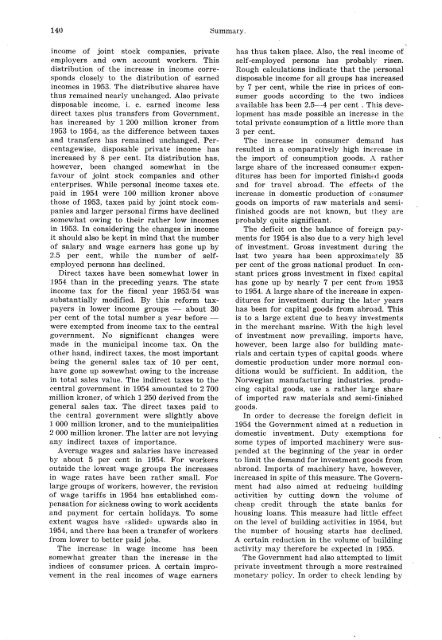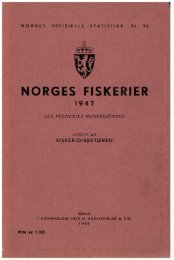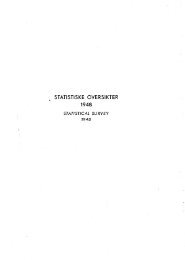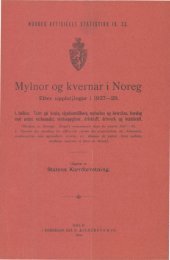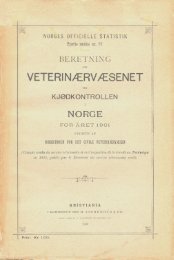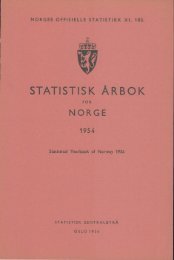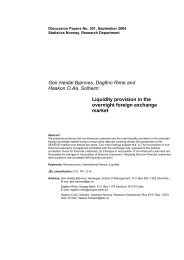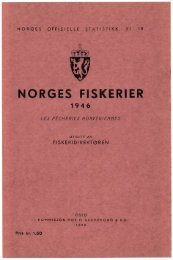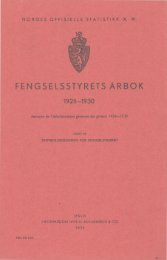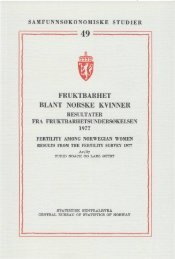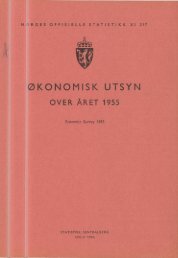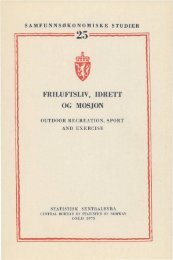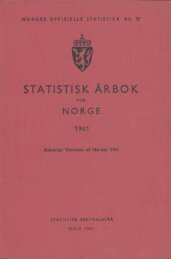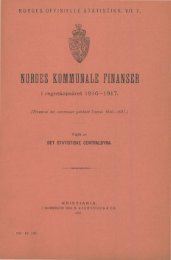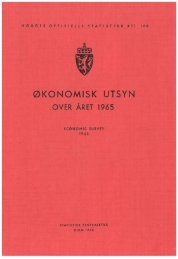XI 190 1954 - Statistisk sentralbyrå
XI 190 1954 - Statistisk sentralbyrå
XI 190 1954 - Statistisk sentralbyrå
Create successful ePaper yourself
Turn your PDF publications into a flip-book with our unique Google optimized e-Paper software.
140 Summary.<br />
income of joint stock companies, private<br />
employers and own account workers. This<br />
distribution of the increase in income corresponds<br />
closely to the distribution of earned<br />
incomes in 1953. The distributive shares have<br />
thus remained nearly unchanged. Also private<br />
disposable income, i. e. earned income less<br />
direct taxes plus transfers from Government,<br />
has increased by 1 200 million kroner from<br />
1953 to <strong>1954</strong>, as the difference between taxes<br />
and transfers has remained unchanged. Percentagewise,<br />
disposable private income has<br />
increased by 8 per cent. Its distribution has,<br />
however, been changed somewhat in the<br />
favour of joint stock companies and other<br />
enterprises. While personal income taxes etc.<br />
paid in <strong>1954</strong> were 100 million kroner above<br />
those of 1953, taxes paid by joint stock companies<br />
and larger personal firms have declined<br />
somewhat owing to their rather low incomes<br />
in 1953. In considering the changes in income<br />
it should also be kept in mind that the number<br />
of salary and wage earners has gone up by<br />
2.5 per cent, while the number of selfemployed<br />
persons has declined.<br />
Direct taxes have been somewhat lower in<br />
<strong>1954</strong> than in the preceding years. The state<br />
income tax for the fiscal year 1953/54 was<br />
substantially modified. By this reform taxpayers<br />
in lower income groups - about 30<br />
per cent of the total number a year before -<br />
were exempted from income tax to the central<br />
government. No significant changes were<br />
made in the municipal income tax. On the<br />
other hand, indirect taxes, the most important<br />
being the general sales tax of 10 per cent,<br />
have gone up sowewhat owing to the increase<br />
in total sales value. The indirect taxes to the<br />
central government in <strong>1954</strong> amounted to 2 700<br />
million kroner, of which 1 250 derived from the<br />
general sales tax. The direct taxes paid to<br />
the central government were slightly above<br />
1 000 million kroner, and to the municipalities<br />
2 000 million kroner. The latter are not levying<br />
any indirect taxes of importance.<br />
Average wages and salaries have increased<br />
by about 5 per cent in <strong>1954</strong>. For workers<br />
outside the lowest wage groups the increases<br />
in wage rates have been rather small. For<br />
large groups of workers, however, the revision<br />
of wage tariffs in <strong>1954</strong> has established compensation<br />
for sickness owing to work accidents<br />
and payment for certain holidays. To some<br />
extent wages have «slided» upwards also in<br />
<strong>1954</strong>, and there has been a transfer of workers<br />
from lower to better paid jobs.<br />
The increase in wage income has been<br />
somewhat greater than the increase in the<br />
indices of consumer prices. A certain improvement<br />
in the real incomes of wage earners<br />
has thus taken place. Also, the real income of<br />
self-employed persons has probably risen.<br />
Rough calculations indicate that the personal<br />
disposable income for all groups has increased<br />
by 7 per cent, while the rise in prices of consumer<br />
goods according to the two indices<br />
available has been 2.5-4 per cent . This development<br />
has made possible an increase in the<br />
total private consumption of a little more th an<br />
3 per cent.<br />
The increase in consumer demand has<br />
resulted in a comparatively high increase in<br />
the import of consumption goods. A rather<br />
large share of the increased consumer expenditures<br />
has been for imported finished goods<br />
and for travel abroad. The effects of the<br />
increase in domestic production of consumer<br />
goods on imports of raw materials and semifinished<br />
goods are not known, but t hey are<br />
probably quite significant.<br />
The deficit on the balance of foreign payments<br />
for <strong>1954</strong> is also due to a very high level<br />
of investment. Gross investment during the<br />
last two years has been approximately 35<br />
per cent of the gross national product In constant<br />
prices gross investment in fixed capital<br />
has gone up by nearly 7 per cent from 1953<br />
to <strong>1954</strong>. A large share of the increase in expenditures<br />
for investment during the later years<br />
has been for capital goods from abroad. This<br />
is to a large extent due to heavy investments<br />
in the merchant marine. With the high level<br />
of investment now prevailing, imports have,<br />
however, been large also for building materials<br />
and certain types of capital goods, where<br />
domestic production under more normal conditions<br />
would be sufficient. In addition, the<br />
Norwegian manufacturing industries, producing<br />
capital goods, use a rather large share<br />
of imported raw materials and semi-finished<br />
goods.<br />
In order to decrease the foreign deficit in<br />
<strong>1954</strong> the Government aimed at a reduction in<br />
domestic investment. Duty exemptions for<br />
some types of imported machinery were suspended<br />
at the beginning of the year in order<br />
to limit the demand for investment goods from<br />
abroad. Imports of machinery have, however,<br />
increased in spite of this measure. The Government<br />
had also aimed at reducing building<br />
activities by cutting down the volume of<br />
cheap credit through the state banks for<br />
housing loans. This measure had little effect<br />
on the level of building activities in <strong>1954</strong>, but<br />
the number of housing starts has declined.<br />
A certain reduction in the volume of building<br />
activity may therefore be expected in 1955.<br />
The Government had also attempted to limit<br />
private investment through a more restrained<br />
monetary policy. In order to check lending by


